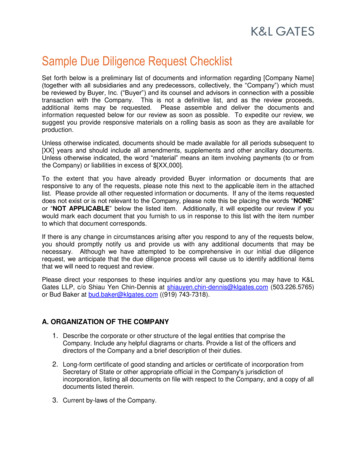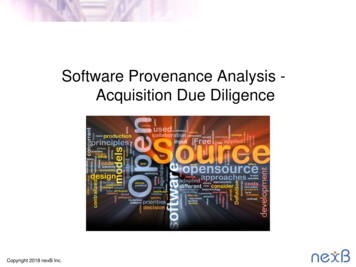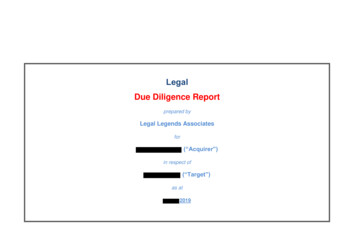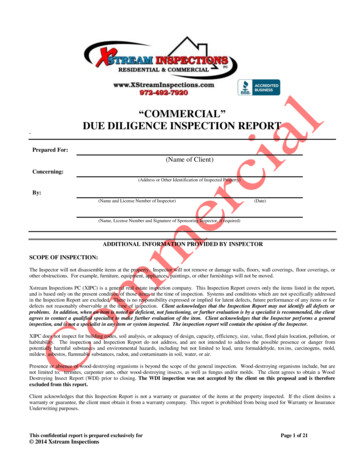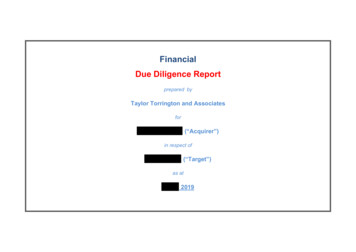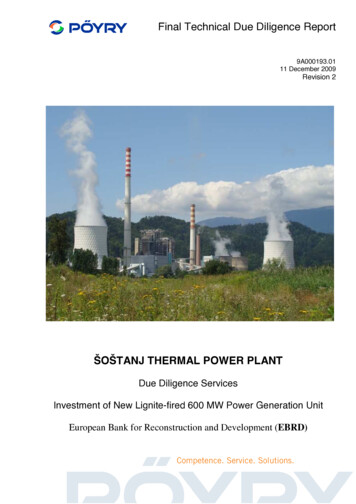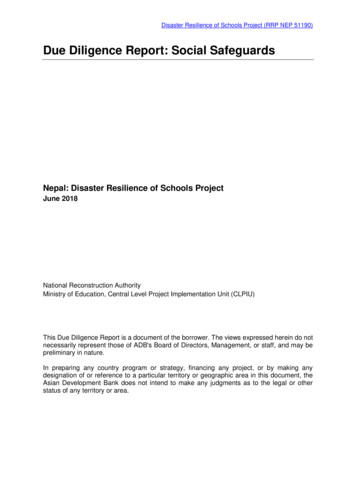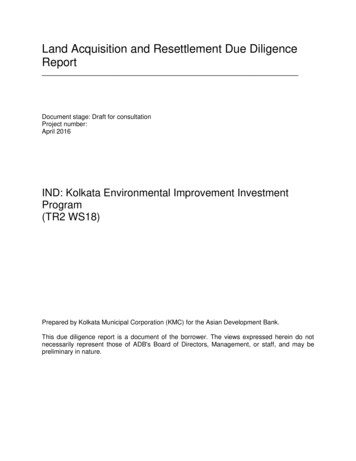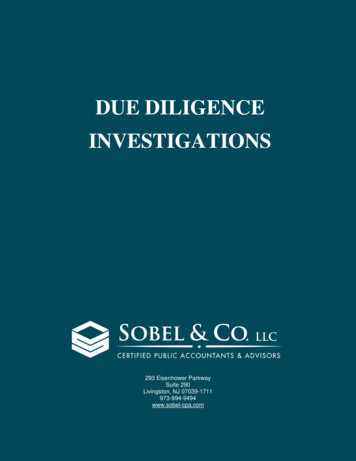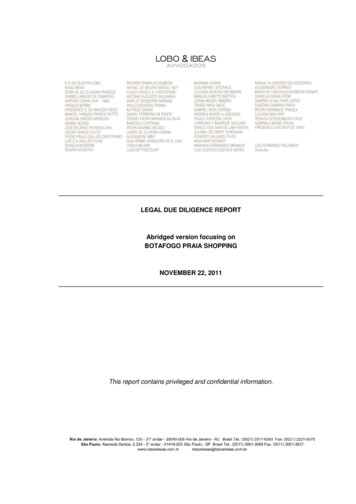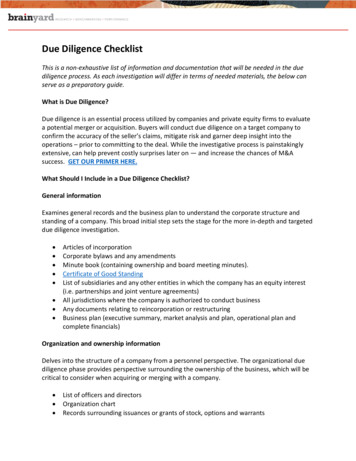
Transcription
Due Diligence ChecklistThis is a non-exhaustive list of information and documentation that will be needed in the duediligence process. As each investigation will differ in terms of needed materials, the below canserve as a preparatory guide.What is Due Diligence?Due diligence is an essential process utilized by companies and private equity firms to evaluatea potential merger or acquisition. Buyers will conduct due diligence on a target company toconfirm the accuracy of the seller’s claims, mitigate risk and garner deep insight into theoperations – prior to committing to the deal. While the investigative process is painstakinglyextensive, can help prevent costly surprises later on — and increase the chances of M&Asuccess. GET OUR PRIMER HERE.What Should I Include in a Due Diligence Checklist?General informationExamines general records and the business plan to understand the corporate structure andstanding of a company. This broad initial step sets the stage for the more in-depth and targeteddue diligence investigation. Articles of incorporationCorporate bylaws and any amendmentsMinute book (containing ownership and board meeting minutes).Certificate of Good StandingList of subsidiaries and any other entities in which the company has an equity interest(i.e. partnerships and joint venture agreements)All jurisdictions where the company is authorized to conduct businessAny documents relating to reincorporation or restructuringBusiness plan (executive summary, market analysis and plan, operational plan andcomplete financials)Organization and ownership informationDelves into the structure of a company from a personnel perspective. The organizational duediligence phase provides perspective surrounding the ownership of the business, which will becritical to consider when acquiring or merging with a company. List of officers and directorsOrganization chartRecords surrounding issuances or grants of stock, options and warrants
List of all shareholderso Include number of shares, dates of issuance and type of consideration receivedDocumentation of past and current shareholder agreements, rights, and other mattersconcerning ownershipo Copies of any voting agreements, trusts or proxieso Copies of right of first offer or refusal and preemptive rightso Transfer restriction agreements and registration agreementsAdministrativeAdministrative due diligence confirms administrative information about a company, like thebusiness facilities, occupancy rate and number of workstations. List of all business locationso Where the company owns/leases property, maintains employees and/orconducts businesso Include applicable details like the occupancy rate and number of workstationsRegulation and complianceThis part of the due diligence stage assesses regulatory or compliance issues with the targetcompany or the overall deal. This process is particularly important in heavily regulatedindustries or with large parties in play. Look in particular for any antitrust risks the deal maypresent. Copy of the company’s compliance policy and written standards of conductCopies of any governmental licenses, permits or consentsAny correspondence, citation, notice or documents relating to any proceedings of anyregulatory agencyAny documents filed with the SEC or any state or foreign securities regulatory agency (ifapplicable)Any material reports to government entities and agencies (including the EPA and OSHA)Analysis of potential antitrust issues (if applicable)Accounting/FinancialConfirms seller’s financial performance by examining both accounting and financialdocumentation. The objective here is to identify any unreported liabilities, understand thetarget’s current financial position and determine if earnings are sustainable. These activitieshelp ensure a realistic valuation of the target and justification of the purchase price. Documentation surrounding the capitalization of the company
Three years of annual and quarterly audited financial statements, with the auditor’sreportsUnaudited financial statements for comparisonLatest interim financial informationFuture financial projectionsDescriptions of strategic plansBudget planAny auditor communication to management for the past five yearsSchedule of accounts receivable and accounts payableA description of depreciation and amortization methods and changes in accountingmethods over the past five years.Copy of the company’s general ledgerCopies of any debt financing documents (i.e. loan agreements, credit agreements,promissory notes, compliance certificates, etc.)Copies of any equity financing documents (i.e. stock purchase agreements, subscriptionagreements, etc.)List of internal control proceduresSchedule of any deferred revenueOperationalOperational due diligence examines the target company’s systems and processes to identifyrisks arising from execution of the business function. Here, buyers assess the effectiveness ofthe target’s operating model — including sales, marketing, technology, supply chain andproduction — to determine gaps and potential areas where investment or development areneeded. The goal is to see if the current state of operations can support the business planprovided by the target company. Overview of company’s operating model showing key systems and processes (bothinsourced and outsourced)Description of the change management process when a change to the operating modelis neededCopies of any documented proceduresOverview of the organizational / functional structure of the teamsList of company’s primary and support activitiesA summary any tests, evaluations, studies, surveys, and other data regarding existingand under development products/servicesIdentification of key performance indicators, value drivers and cost driversInformation around sales and marketing procedures, including research, messaging,CRM systems and processes, and lead generation practicesList of all third parties in the supply chainA breakdown by manufacturing site of the products manufactured, personnelemployed, number of shifts and capacity
Documentation around supply chain processes (i.e. delivery times, inventory availability,transportation mode/costs, facility costs, inventory investment, contract manufacturers,etc.)List of main suppliers and their discounts, terms and credit limitsDetails around distribution model and channelsTaxDelves into the target’s tax profile by analyzing tax returns and the company’s tax structure. Taxexamination is a highly emphasized area of due diligence, as the acquiring company will beliable for any tax issues it inherits. Federal, state, local and foreign income tax returns for the last three yearsState sales tax returns for the last three yearsExcise tax filings for three yearsEmployment tax filings for past three yearsDocumentation around tax structure and key tax electionsAny audit adjustments proposed by the IRSDocumentation around any tax liens or settlementsCopies of any audit and revenue agency reportsLegalReviews the legal matters facing a company and related risk around contracts or litigation. Legaldue diligence greatly affects how, or if, a deal will move forward. Issues like restrictive and/orbreached contracts, noncompete clauses and past or pending litigation will influence thestructure of a deal. After all, post-transaction, the buyer is going to be liable for any obligations,contingencies and restrictions. Any pending or threatened litigation against or initiated by the companyAny settled or concluded litigation against or initiated by the companyAll active litigation filesAny consent decrees, injunctions, judgments, settlements or other ordersCopies of all contractsAny loan agreements, bank financing agreements, and lines of credit to which companyis a partyLicensing or franchise agreementsCopy of all guarantees to which the company is a partyInformation as to any past or present governmental investigationCopies of all attorneys' responses to audit inquiries and all attorneys’ letters to auditors
TechnologicalThe technological aspect of the due diligence process examines the company’s IT assets (or lackthereof) to assess sustainability, value, costs, scalability and evolution capabilities, as well ashow systems would integrate into the buyer’s company or portfolio. People and processes needto be proven effective and adaptable. A cybercrime proliferates, an increasingly importantfocus is the vulnerability inherent in the IT infrastructure. List of software used by the company and copies of any applicable licensing agreementsAny IT outsourcing agreementsCurrent system usage and ageA list of interfaces that link systems togetherDocumentation around IT processes including applications development, IT operations,disaster recovery, IT security, and cost managementInformation around security and controls frameworkDetails surrounding any hack, breach or any other cybersecurity incidentPhysical assetsAsset due diligence verifies the tangible assets possessed by the target. This involves confirmingthe existence, value, age, quality and ownership of a company’s real estate, fixed assets andinventory. List of all owned or leased properties and applicable details (i.e. rent amount, location,dates, etc.)Details on all sales and purchases of major capital equipment in the last three yearsCopies of all lease agreements for equipmentCopies of real estate deeds, appraisals, mortgages, leases, surveys, title policies, usepermits and any other relevant documentationSchedule of owned and leased fixed assets, including description, date acquired, valueand locationCopies of any equipment appraisalsCopy of inventory listing, including item description, item number, date, units, and costfor the most recent year-end and month-endDescription of practices regarding inventory aging, valuation, and obsolescence, and anymethodology changesAny UCC filingsIntellectual property (IP)Particularly in technology-driven industries, a target company’s IP portfolio largely determinesits value and relevance to the combined company. IP due diligence should gauge the materialityof the IP portfolio and ensure that there are no inherent ownership issues present.
Schedule and copies of all intellectual property registrations and pending applicationo Patents and patent applicationso Trademark registrations, trademark applications and trade nameso Registered and material unregistered copyrightsCopies of the chain of title recordsDocumentation around any claims or threatened claims by or against the companyregarding IPCopies of any IP-related agreements (i.e. licensing, collaboration, research anddevelopment, etc.).List of the company’s active websites and social media accountsDocumentation around all proprietary and/or customized software and IT systemsutilized by the companyGeneral descriptions around proprietary know-how, trade secrets, technology and/orprocessesDocuments detailing the company’s approach to IP protection and enforcement (i.e.confidentiality and non-disclosure agreements, employment agreements around IP,etc.)A list of all licensing revenue and expensesHuman resourcesHR due diligence analyzes the critical people component of the M&A transaction. It takes intoaccount information like total number of employees, demographics, compensation, benefitplans, human resource policies, contracts and organizational structure. The data garnered onthe personnel involved will help an acquiring company determine key employees and anintegration plan should the transaction move forward. Employee demographic information (age, location, title, tenure, skillset, compensation,etc.)Employee handbook (should cover policies, benefits, procedures and training)Files containing all employee relations matters – including any past/current disputes orcomplaintsAll employee, non-disclosure, non-solicitation and non-compete agreementsCopies of all stock option and stock purchase plansResumes of key employeesDocumentation around qualified and nonqualified retirement plansAssessment of the competencies, skillsets and capabilities of employeesPerformance review schedules and structureRecruiting and onboarding processCopies of payroll documentsCopies of any labor or employments contracts
CommercialCommercial due diligence examines the target’s ecosystem to determine its place in themarket. This process delves into market conditions, trends, consumers, competitors,opportunities/threats and differentiators. List of products and services offered and in developmentMarket research including size, share, trends, drivers, demand, conditions,opportunities, threats, differentiators and outlookProfiles of major competitorsList of top customersCustomer analysis including customer segments, demographics, churn rate, satisfaction,customer acquisition cost, NPS score and lifetime valueList of major suppliersIdentification of any barriers to entry in the marketplaceA summary of all complaints or warranty claimsCopies of long-term sales contractsAgreements with distributors, value-added resellers and dealersEnvironmentalThis type of due diligence identifies environmental, health and safety issues that could directlyaffect the value and reputation of the target business, and by association, the buyer’s largerorganization. Interviews with past and present owners, operators and occupantsCopies of any violations, complaints or requests for information regardingenvironmental, workplace safety and health (from private parties or governmentalauthorities)Historical sources of information (i.e. aerial photographs, fire insurance maps, chain oftitle documents, and land use records)Federal, state, local and tribal government recordsRecords concerning adjoining or neighboring propertiesPermits and records relating to environmental matters such as underground storagetanks, air quality, water use, solid/liquid wastes and hazardous waste storage or disp
Due diligence is an essential process utilized by companies and private equity firms to evaluate a potential merger or acquisition. Buyers will conduct due diligence on a target company to confirm the accuracy of the seller’s claims, mitigate risk and garner deep insight into the operations – prior to committing to the deal. While the investigative process is painstakingly extensive, can .
